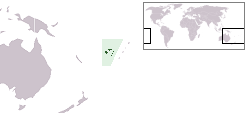Rabi Island

Map of Fiji
|
|
 |
|
| Geography | |
|---|---|
| Location | Fiji |
| Coordinates | 16°30′S 180°0′W / 16.500°S 180.000°WCoordinates: 16°30′S 180°0′W / 16.500°S 180.000°W |
| Archipelago | Vanua Levu Group |
| Adjacent bodies of water | Koro Sea |
| Area | 67.3 km2 (26.0 sq mi) |
| Length | 15 km (9.3 mi) |
| Administration | |
|
Fiji
|
|
| Division | Northern |
| Province | Cakaudrove |
| Largest settlement | Tabwewa (pop. 600) |
| Demographics | |
| Population | 5000 (2014) |
| Pop. density | 74.3 /km2 (192.4 /sq mi) |
| Ethnic groups | Banabans 95%, Native Fijians 4%, Other 1% |
Rabi (pronounced [ˈrambi]) is a volcanic island in northern Fiji. It is an outlier to Taveuni (5 kilometers west), in the Vanua Levu Group. It covers an area of 66.3 square kilometers, reaching a maximum altitude of 463 meters and has a shoreline of 46.2 kilometers. With a population of around 5,000, Rabi is home to the Banabans who are the indigenous landowners of Banaba Island; the indigenous Fijian community that formerly lived on Rabi was moved to Taveuni after the island was purchased by the Banabans. The original inhabitants still maintain their links to the island, and still use the Rabi name in national competitions.
Rabi has four main settlements – all named after, and populated by the descendants of, four villages on Banaba that were destroyed by the invading Japanese forces in the Second World War. Tabwewa Village, formerly known as Nuku in Fijian, is the administrative centre of Rabi. Located in the far north of the island, Tabwewa boasts administrative buildings, a wharf, a post office, court house, a hospital, and a guest house – the only one on the island. 14 kilometers to the south of Tabwewa is Tabiang (formerly Siosio), the home of Rabi's only school and an airstrip. Other major settlements include Uma (formerly Wiinuku), between Tabwewa and Tabiang, and Buakonikai (formerly Aoteqea), some 22 kilometers from Tabwewa. Rabi is the eighth largest island of Fiji and the antimeridian passes through this island.
Rabi was the first place in Fiji where Indian indentured labourers were employed. When the first Indians were brought to Fiji abroad the Leonidas in 1879, most European planters refused to employ them because of the extra cost involved. One planter who was sympathetic to Government policies was Captain J. Hill of Rabi Island, and he agreed to take 106 of indentured labourers as field workers.
...
Wikipedia
